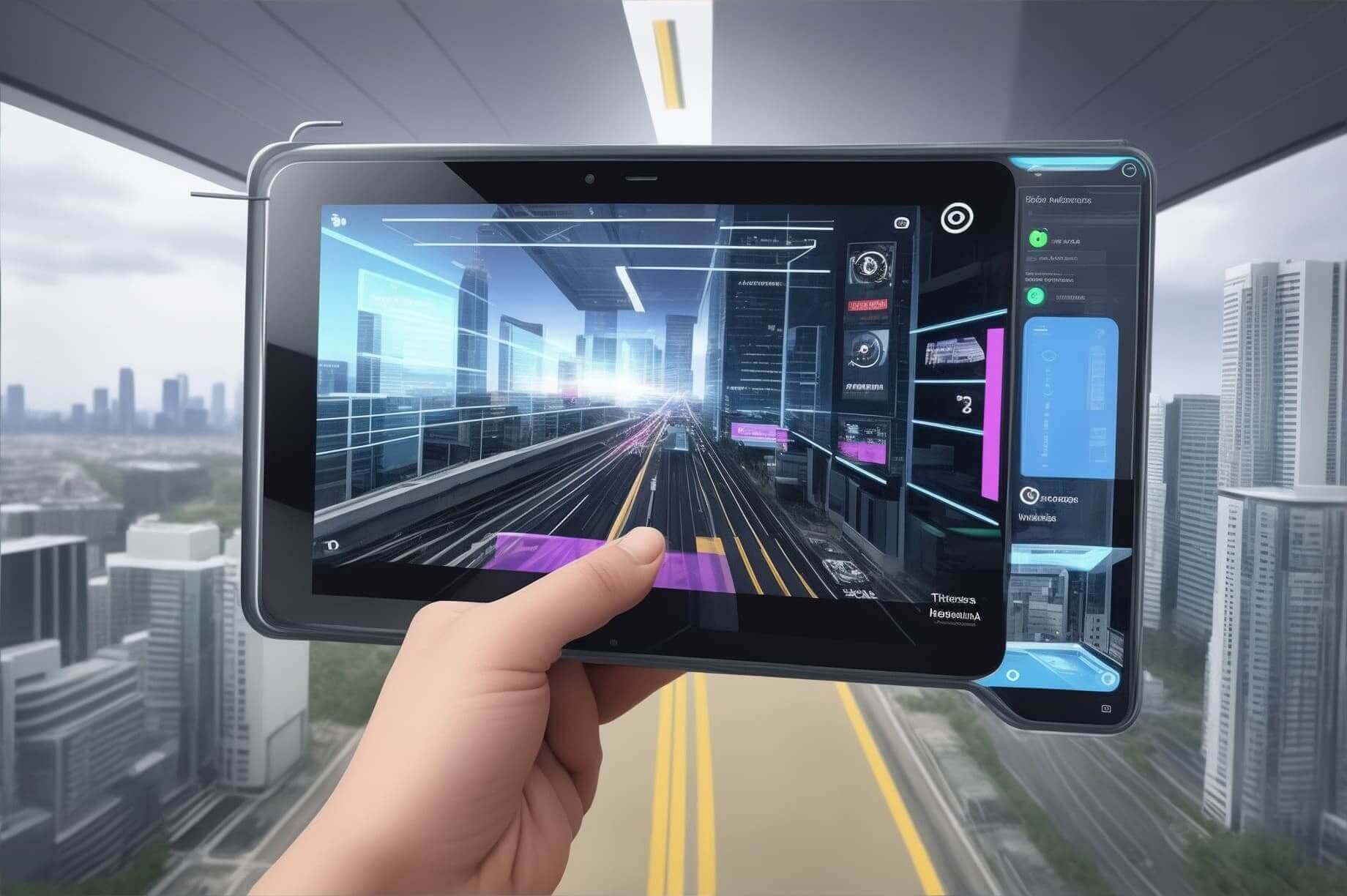Augmented Reality (AR) is revolutionizing the way we interact with the world around us. This cutting-edge technology is increasingly being utilized in various industries, from gaming to healthcare, and even retail. AR enhances our perception of reality by overlaying digital information onto the physical world, creating a seamless and immersive experience.
What is Augmented Reality?
AR is a technology that blends the real world with digital elements, creating an enhanced environment. Unlike Virtual Reality (VR), which replaces the real world with a completely virtual one, AR adds layers of digital information onto our physical surroundings.
AR can be experienced through different devices, such as smartphones, tablets, smart glasses, or headsets. These devices use sensors, cameras, and computer algorithms to track the user’s position and surroundings, allowing them to interact with virtual objects in real-time.
This technology has the potential to revolutionize various industries. In gaming, AR can bring characters and objects into our physical environment, making the gaming experience more immersive and interactive. In healthcare, it can assist surgeons during complex procedures by providing real-time information and visual guides. Retailers can use AR to enhance the shopping experience by allowing customers to try on virtual clothing or visualize furniture in their homes before making a purchase.
AR is also making its way into education, architecture, and marketing, among other fields, transforming the way we learn, create, and promote products and services.
With its ability to overlay digital information onto the real world, Augmented Reality is reshaping our perception and interaction with the environment, offering endless possibilities for innovation and growth in various industries.
The Basics of Augmented Reality
Augmented Reality (AR) is a technology that overlays digital information and virtual objects onto the real world, enhancing our perception of reality. It is transforming the way we interact with the world around us, offering countless possibilities in various fields, from entertainment and gaming to education and healthcare.
How does Augmented Reality work?
AR works by utilizing sensors, cameras, and computer algorithms to detect and track the real-world environment. It then integrates virtual elements into this environment in real-time, seamlessly blending the digital and physical worlds. This is typically achieved through devices such as smartphones, tablets, or smart glasses, which act as the AR interface.
Different types of Augmented Reality
There are different types of augmented reality that cater to different needs and purposes:
- Marker-based AR: This type of AR relies on the recognition of markers, such as QR codes or specific images, to trigger the display of virtual content. When the device’s camera detects the marker, it generates the corresponding augmented elements.
- Markerless AR: Also known as location-based AR, this type of AR uses GPS, compass, and other sensors to determine the user’s location and orientation. It then overlays relevant digital information onto the user’s real-world environment.
- Projection-based AR: In this type of AR, virtual content is projected onto real-world objects or surfaces. The projected images or animations can interact with the physical elements, creating an immersive experience.
Augmented Reality is revolutionizing the way we perceive and interact with our surroundings. Its applications are vast and continually expanding, offering endless opportunities for businesses, educators, and individuals to enhance their experiences and gain new perspectives.
Applications of Augmented Reality in Various Industries
Augmented Reality (AR) technology has taken the world by storm, revolutionizing the way we interact with the world around us. From education to healthcare, retail, and entertainment, AR is playing a significant role in enhancing user experiences and transforming various industries.
Augmented Reality in Education
AR has the potential to transform the education sector by making learning more engaging and interactive. Imagine students being able to visualize complex concepts through 3D models or taking virtual tours of historical landmarks. AR can provide a hands-on learning experience that helps students grasp concepts more effectively.
Augmented Reality in Healthcare
In healthcare, AR is being used to improve training and surgical procedures. Surgeons can use AR to overlay digital information onto a patient’s body, providing real-time guidance during surgeries. Additionally, AR can assist in medical education, allowing students to practice procedures virtually before performing them on real patients.
Augmented Reality in Retail
AR is revolutionizing the retail industry by enhancing the shopping experience. Customers can use AR apps to try on clothes virtually or visualize products in their own homes before making a purchase. This technology allows retailers to provide a more personalized and immersive shopping experience, increasing customer satisfaction.
Augmented Reality in Entertainment
AR has opened up new possibilities in the entertainment industry. It allows users to experience virtual reality games and interactive storytelling. AR enables filmmakers to create immersive movie experiences, blending the real world with virtual elements.
With its versatility and potential for innovation, Augmented Reality is transforming the way we interact with the world. From enhancing education to revolutionizing healthcare, retail, and entertainment, AR is shaping the future of various industries.
Advantages and Disadvantages of Augmented Reality
Advantages of Augmented Reality
Augmented reality (AR) has revolutionized the way we interact with the world around us. Here are some key advantages of this technology:
- Enhanced User Experience: AR enhances the user experience by overlaying digital information onto the real world. It allows users to see and interact with additional virtual content, providing a more immersive and engaging experience.
- Improved Learning and Training: AR has proven to be a valuable tool in education and training. It enables learners to visualize complex concepts, providing a hands-on experience that enhances understanding and retention.
- Increased Productivity: Businesses can use AR to streamline workflows and enhance productivity. For example, maintenance technicians can use AR glasses to view repair instructions or remote experts can provide real-time guidance, minimizing downtime and improving efficiency.
- Marketing and Advertising: AR opens up new possibilities for marketing and advertising campaigns. Brands can create interactive experiences that engage customers and leave a lasting impression, ultimately driving sales and brand loyalty.
Disadvantages of Augmented Reality
While augmented reality offers numerous advantages, there are also some drawbacks to consider:
- Costly Implementation: Implementing AR technology can be expensive, especially for smaller businesses. The cost of developing customized AR applications or purchasing AR devices can be a barrier to adoption.
- Privacy and Security Concerns: AR relies on personal data and real-time tracking, raising concerns about privacy and security. Users may feel uncomfortable with the collection and use of their personal information, making it crucial for companies to address these concerns.
- Technical Limitations: AR technology is still evolving, and there are technical limitations to consider. These include the need for powerful hardware, potential compatibility issues, and the challenge of creating seamless and realistic AR experiences.
Despite these challenges, the potential of augmented reality is undeniable. As the technology continues to advance, it promises to transform various industries and reshape the way we interact with the world.
Major Players in the Augmented Reality Space
Microsoft HoloLens
Microsoft HoloLens is a game-changer in the augmented reality (AR) industry. By blending the virtual world with the real world, HoloLens enables users to interact with digital content in 3D space. With its advanced sensors and spatial sound technology, HoloLens provides an immersive experience for various applications, including gaming, entertainment, education, and healthcare. Microsoft’s commitment to developing the HoloLens platform and collaborating with developers has contributed to its success as a leading AR solution.
Google Glass
Google Glass, an innovative wearable device, introduced the concept of augmented reality to the masses. With a compact design and voice command capabilities, users can easily access information displayed in a small screen positioned just above their eyes. Although the first iteration faced some challenges, Google continues to refine and explore applications for this technology. From enhancing productivity in the workplace to assisting medical professionals during surgeries, Google Glass has the potential to revolutionize various industries.
Magic Leap
Magic Leap stands out in the augmented reality space for its cutting-edge technology and emphasis on spatial computing. Their flagship product, Magic Leap One, combines advanced optics, sensors, and a wearable computer to seamlessly blend digital content with the real world. The spatial computing capabilities allow for realistic and interactive experiences, making it suitable for gaming, entertainment, design, and enterprise applications. Magic Leap’s commitment to pushing the boundaries of AR has garnered attention from investors and industry influencers alike.
Overall, these major players in the augmented reality space have made significant contributions to transforming the way we interact with the world. As technology continues to advance, we can expect even more exciting developments in the field of augmented reality.
The Future of Augmented Reality
Emerging trends in Augmented Reality
If you think Augmented Reality (AR) is only limited to gaming and entertainment, think again. The future of AR holds immense potential in transforming the way we interact with the world. Here are some emerging trends in AR that are shaping the future:
- AR in healthcare: AR has the power to revolutionize the healthcare industry by providing real-time information to surgeons during surgeries, assisting in medical training, and improving patient outcomes. It enables doctors to visualize and manipulate medical images, leading to better accuracy and efficiency in diagnoses and treatments.
- AR in education: AR has the capacity to enhance learning experiences by bringing interactive and immersive elements into classrooms. From virtual field trips to visualizing complex concepts, AR can make education more engaging and effective.
- AR in retail: AR is reshaping the retail industry by enhancing the in-store experience and bridging the gap between online and offline shopping. AR allows customers to virtually try on products, visualize how furniture would look in their homes, and receive personalized recommendations, leading to increased customer satisfaction and sales.
Potential impact of Augmented Reality on society
The impact of AR on society is vast and far-reaching. Here are some potential impacts:
- Improved productivity: AR can improve productivity in various industries by providing real-time information, instructions, and guidance to workers, enabling them to perform tasks more efficiently and accurately.
- Enhanced communication and collaboration: AR can facilitate remote collaboration by overlaying virtual elements on a real-world environment, allowing people to interact and work together regardless of their physical location.
- Expanded entertainment possibilities: AR offers limitless possibilities for entertainment, from immersive gaming experiences to interactive storytelling and live performances.
As AR technology continues to advance, its potential to transform industries and society as a whole becomes increasingly evident. Embracing the future of Augmented Reality opens up exciting possibilities for how we interact with the world around us.
Challenges and Limitations of Augmented Reality
Augmented Reality (AR) has undoubtedly transformed the way we interact with the world, enhancing our reality with digital overlays. However, like any emerging technology, AR also faces challenges and limitations that need to be addressed.
Technical limitations of Augmented Reality
- Hardware Requirements: To experience AR, users need to have devices capable of running AR applications. This can be a barrier for widespread adoption as not everyone may have access to the required hardware.
- Processing Power: AR applications require significant processing power to render complex 3D objects in real-time. This can lead to performance issues on devices with lower processing capabilities.
- Accuracy and Calibration: Achieving accurate and precise overlay of digital content onto the real world can be a challenge. Any misalignment or mismatch can result in a less immersive experience.
Ethical and privacy concerns
- Data Privacy: AR applications often collect user data, such as location information and personal preferences. This raises concerns about how this data is stored, used, and protected, as well as the potential for unauthorized access or misuse.
- Security Risks: With AR, users may be exposed to new security risks, such as cyber attacks or malicious content embedded within digital overlays. Ensuring the security of AR systems is crucial to protect users and their information.
- Impact on Social Interactions: As AR becomes more prevalent, there is a potential for it to negatively impact real-life social interactions. Excessive use of AR devices may lead to a decrease in human connection and engagement.
Despite these challenges and limitations, the potential of Augmented Reality remains immense. Addressing these issues will promote wider adoption and ensure responsible and ethical use of this transformative technology.
Conclusion
Augmented Reality (AR) is a revolutionary technology that is transforming the way we interact with the world. It has the potential to revolutionize various industries, including gaming, education, healthcare, and retail. By overlaying digital objects onto the real world, AR enhances our perception of reality and opens up endless possibilities for innovation and creativity.
Summary of the key points
- Enhanced experiences: AR enables us to see and interact with digital content in the real world, enhancing our experiences and providing new opportunities for entertainment, learning, and problem-solving.
- Improved productivity: AR can streamline workflows and improve efficiency in fields such as manufacturing, logistics, and maintenance by providing workers with real-time information and guidance.
- Personalized interactions: AR allows businesses to create customized and immersive experiences for their customers, leading to increased engagement, satisfaction, and brand loyalty.
- Transforming education: AR has the potential to revolutionize education by making learning more interactive and engaging. It can bring abstract concepts to life and provide students with hands-on experiences.
Final thoughts on the transformative power of Augmented Reality
Augmented Reality has the power to reshape our world by merging the digital and physical realms. It has the potential to revolutionize industries, improve everyday experiences, and unlock new opportunities for innovation and creativity. As AR continues to evolve and become more accessible, we can expect to see even more exciting applications and advancements in the years to come. Embracing AR and staying ahead of the curve will be crucial for businesses and individuals looking to thrive in this rapidly changing digital landscape.





